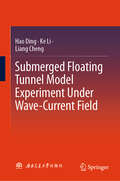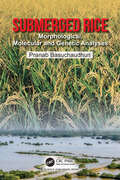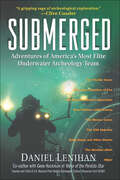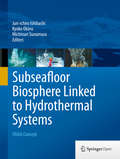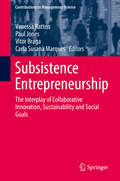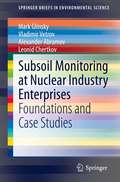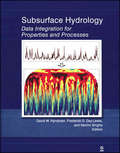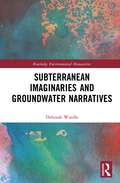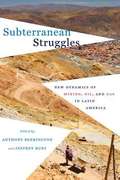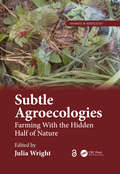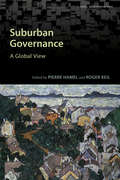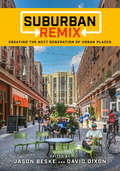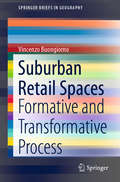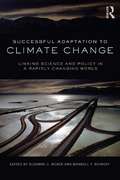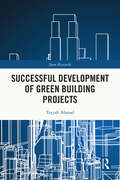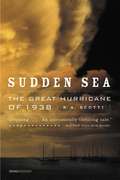- Table View
- List View
Submerged Floating Tunnel Model Experiment Under Wave-Current Field
by Liang Cheng Ke Li Hao DingThis book conducts research on the overall design of the submerged floating tunnel, structural safety standards, environmental load calculation methods, pipe structure selection, joint structure form, anchoring mode, collision avoidance technology, operation ventilation and disaster prevention, etc., and proposes a preliminary engineering technical plan for the submerged floating tunnel in Qiongzhou Strait. It focuses on the domestic and foreign research status of submerged floating tunnels, model experiment theory and method, experimental system, model design, experimental process, experimental results analysis, and other unique achievements and thoughts. This book is suitable for tunnel engineering scientists, tunnel engineering designers, civil engineers, traffic planning designers, civil engineering students, and teachers. Because submerged floating tunnel is a kind of tunnel structure full of innovation and challenge, research results on suspended tunnels are relatively rare. This book includes the design scheme of submerged floating tunnel, model experiment theory, experimental system, analysis of experimental results, etc., which can provide ideas for the current design of submerged floating tunnel, and also provides useful reference for scholars engaged in the research of basic theory and key technology of submerged floating tunnel and related fields.
Submerged Landscapes of the European Continental Shelf: Quaternary Paleoenvironments
by Anthony Burgess Nicholas C. Flemming Jan Harff Delminda Moura Geoffrey N. BaileyQuaternary Paleoenvironments examines the drowned landscapes exposed as extensive and attractive territory for prehistoric human settlement during the Ice Ages of the Pleistocene, when sea levels dropped to 120m-135m below their current levels. This volume provides an overview of the geological, geomorphological, climatic and sea-level history of the European continental shelf as a whole, as well as a series of detailed regional reviews for each of the major sea basins. The nature and variable attractions of the landscapes and resources available for human exploitation are examined, as are the conditions under which archaeological sites and landscape features are likely to have been preserved, destroyed or buried by sediment during sea-level rise. The authors also discuss the extent to which we can predict where to look for drowned landscapes with the greatest chance of success, with frequent reference to examples of preserved prehistoric sites in different submerged environments. Quaternary Paleoenvironments will be of interest to archaeologists, geologists, marine scientists, palaeoanthropologists, cultural heritage managers, geographers, and all those with an interest in the drowned landscapes of the continental shelf.
Submerged Rice: Morphological, Molecular and Genetic Analyses
by Pranab BasuchaudhuriWater stagnation and submergence are major factors in rice growing. Water stagnation and submergence happen as a result of excessive rainfall or flash floods. The duration of submergence can last several weeks, and the level of water may be as high as 100 cm. This impacts rice yields. This book analyzes different aspects, viz., morphology, physiology, biochemistry and genetics, and reviews the suitability of different varieties for better sustainability and reduction of yield loss. It also reviews the different types of floods, and studies biological changes in indigenous and recently developed rice varieties. There are seven chapters: Introduction, History of floods, Diversity of submergence, Adoptive morphology, Physiological aspects, Molecular and genetic aspects, and Yield and yield-gaps. It is comprehensive with scientific dogma, findings and reasonings for students at universities and researchers.
Submerged: Adventures of America's Most Elite Underwater Archeology Team
by Daniel LenihanDaniel Lenihan’s Submerged shares stories of underwater expeditions in “an adventure-packed ride that rivals any Clive Cussler tome” (Archeology Magazine).Experience a kaleidoscope of real-life underwater missions as revealed by the Founder and Chief of U.S. National Park Service Submerged Cultural Resources Unit (SCRU), ranging from ancient ruins covered by reservoirs in the desert Southwest to a World War II submarine off the Alaskan coast; from the Isle Royale shipwrecks in the frigid Lake Superior to the USS Arizona in Pearl Harbor; from the HL Hunley, the first submarine in history to sink an enemy ship, in Charleston Harbor to the ships sunk by atomic bombs at Bikini Atoll, and much more. “A gripping saga of archeological exploration.” —#1 New York Times–bestselling author Clive Cussler“An edge-of-your-seat story that succinctly illustrates the danger of wreck exploration. Lenihan’s enthusiasm and obvious love for uncovering the past is infectious.” —The Post and Courier (Charleston, SC)“Submerged takes readers on an exciting tour of some of the world’s most interesting dive sites and provides them with a fascinating glimpse into the world of underwater archeology.” —Sport Diver
Subpixel Mapping for Remote Sensing Images
by Lei Zhang Peng WangSubpixel mapping is a technology that generates a fine resolution land cover map from coarse resolution fractional images by predicting the spatial locations of different land cover classes at the subpixel scale. This book provides readers with a complete overview of subpixel image processing methods, basic principles, and different subpixel mapping techniques based on single or multi-shift remote sensing images. Step-by-step procedures, experimental contents, and result analyses are explained clearly at the end of each chapter. Real-life applications are a great resource for understanding how and where to use subpixel mapping when dealing with different remote sensing imaging data. This book will be of interest to undergraduate and graduate students, majoring in remote sensing, surveying, mapping, and signal and information processing in universities and colleges, and it can also be used by professionals and researchers at different levels in related fields.
Subseafloor Biosphere Linked to Hydrothermal Systems
by Jun-Ichiro Ishibashi Kyoko Okino Michinari SunamuraThis book is the comprehensive volume of the TAIGA ("a great river " in Japanese) project. Supported by the Japanese government, the project examined the hypothesis that the subseafloor fluid advection system (subseafloor TAIGA) can be categorized into four types, TAIGAs of sulfur, hydrogen, carbon (methane), and iron, according to the most dominant reducing substance, and the chemolithoautotrophic bacteria/archaea that are inextricably associated with respective types of TAIGAs which are strongly affected by their geological background such as surrounding host rocks and tectonic settings. Sub-seafloor ecosystems are sustained by hydrothermal circulation or TAIGA that carry chemical energy to the chemosynthetic microbes living in an extreme environment. The results of the project have been summarized comprehensively in 50 chapters, and this book provides an overall introduction and relevant topics on the mid-ocean ridge system of the Indian Ocean and on the arc-backarc systems of the Southern Mariana Trough and Okinawa Trough.
Subsidence Analysis and Visualization: For Sedimentary Basin Analysis and Modelling (SpringerBriefs in Petroleum Geoscience & Engineering)
by Eun Young Lee Johannes Novotny Michael WagreichThis book provides a comprehensive introduction to techniques for quantitative subsidence analysis and visualization with example applications. Subsidence analysis is an essential step to understand basin evolution through geologic time and space in the study of sediments and sedimentary basins. Quantifying techniques have been developed and applied in many basin research projects to evaluate total, tectonic and thermal subsidence. They are also a pre-requisite for basin evolution modelling. Recent studies have applied visualization techniques to understand regional subsidence contexts and trends, which confirmed that three-dimensional visualization of the basin subsidence is highly helpful to gain insight into basin evolution. In this book, we show how geoscience and computer science can be effectively combined in advanced basin analysis, especially in terms of basin subsidence. Each type of subsidence analysis is introduced with example applications. In particular we present a study of the Vienna basin using BasinVis, a MATLAB-based program for analyzing and visualizing basin subsidence. Given its breadth of coverage, this book will benefit students in undergraduate and postgraduate courses and provide helpful information for research projects and industry applications.
Subsistence Agriculture in the US: Reconnecting to Work, Nature and Community (Routledge-SCORAI Studies in Sustainable Consumption)
by Ashley ColbyFocusing on ethnography and interviews with subsistence food producers, this book explores the resilience, innovation and creativity taking place in subsistence agriculture in America. To date, researchers interested in alternative food networks have often overlooked the somewhat hidden, unorganized population of household food producers. Subsistence Agriculture in the US fills this gap in the existing literature by examining the lived experiences of people taking part in subsistence food production. Over the course of the book, Colby draws on accounts from a broad and diverse network of people who are hunting, fishing, gardening, keeping livestock and gathering and looks in depth at the way in which these practical actions have transformed their relationship to labor and land. She also explores the broader implications of this pro-environmental activity for social change and sustainable futures. With a combination of rigorous academic investigation and engagement with pressing social issues, this book will be of great interest to scholars of sustainable consumption, environmental sociology and social movements.
Subsistence Entrepreneurship: The Interplay of Collaborative Innovation, Sustainability and Social Goals (Contributions to Management Science)
by Paul Jones Vanessa Ratten Vitor Braga Carla Susana MarquesThis book focuses on the role of subsistence entrepreneurs in creating social and sustainable business opportunities on the global marketplace. Subsistence entrepreneurs use scarce resources to create new business opportunities, often in developing or emerging economies. In addition, subsistence entrepreneurship is increasingly being used as a way to facilitate market entry for small and medium-sized business enterprises that focus on collaborative innovation. The interdisciplinary contributions gathered here will expand readers’ understanding of the nature and characteristics of subsistence entrepreneurs, as well as the challenges they face. The central connection between subsistence, sustainability and social entrepreneurship is also explored.
Subsoil Constraints for Crop Production
by Teogenes Senna de Oliveira Richard Willian BellThis book will address the major subsoil physical and chemical constraints and their implications to crop production; Plant growth is often restricted by adverse physical and chemical properties of subsoils yet these limitations are not revealed by testing surface soils and hence their significance in crop management is often overlooked. The major constraints can be physical or chemical. Physical limitations such as poor/nil subsoil structure, sandy subsoils that do not provide adequate water or gravelly subsoils and, etc. On the other hand, chemical constraints include acidity/alkalinity, high extractable Al or Mn, low nutrient availability, salts, boron toxicity and pyritic subsoils. Some of these constraints are inherent properties of the soil profile while others are induced by crop and soil management practices. This aim of this book is to define the constraints and discuss amelioration practices and benefits for crop production. This book will be of interest to readers involved with agriculture and soil sciences in laboratory, applied or classroom settings.
Subsoil Improvement
by Jürgen SchmittThis book provides a comparison of methods in the form of tables, which can be used to make a rough pre-selection of possible soil improvement methods. The stability and serviceability of structures (ground failure, slope failure, settlement, slide safety, etc.) depend on the nature and magnitude of the forces acting and the physical properties of the ground. If the properties of the subsoil do not meet the requirements to be met, an improvement of the properties can be considered.This book describes the most common and established methods for improving the properties of the subsoil. In addition to explaining the process, it provides the requirements for using the process and information such as the maximum depths that can be improved or the strengths that can be achieved.The book is aimed primarily at students and practitioners in civil engineering, architecture, and engineering geology.
Subsoil Monitoring at Nuclear Industry Enterprises: Foundations and Case Studies (SpringerBriefs in Environmental Science)
by Mark Glinsky Vladimir Vetrov Alexander Abramov Leonid ChertkovThis book is the first comprehensive review of the subsurface monitoring theory and practice. It presents all aspects of a subsurface monitoring system SM-NI to be organized in impacted areas of nuclear industry enterprises. The content of the book covers the whole set of the SM-NI projecting and implementation issues – from the theoretical and regulatory framework, through the description of the sources of impact on geological environment to examples of use the SM-NI to solve environmental problems on the main types of environmentally significant nuclear industry enterprises. Development of the SM-NI was based on long-term research studies including modeling of pollutants transport in the geological environment.The book is intended for a wide range of nuclear industry employees and specialists in environment protection and radiation safety of nuclear industry enterprises. It might be useful for ecologists, students and postgraduates concerned about environment protection in the field of nuclear technology
Subsurface Environmental Modelling Between Science and Policy (Advances in Geophysical and Environmental Mechanics and Mathematics)
by Dirk Scheer Holger Class Bernd FlemischThis book provides a broad overview of essential features of subsurface environmental modelling at the science-policy interface, offering insights into the potential challenges in the field of subsurface flow and transport, as well as the corresponding computational modelling and its impact on the area of policy- and decision-making. The book is divided into two parts: Part I presents models, methods and software at the science-policy interface. Building on this, Part II illustrates the specifications using detailed case studies of subsurface environmental modelling. It also includes a systematic research overview and discusses the anthropogenic use of the subsurface, with a particular focus on energy-related technologies, such as carbon sequestration, geothermal technologies, fluid and energy storage, nuclear waste disposal, and unconventional oil and gas recovery.
Subsurface Hydrology: Data Integration for Properties and Processes (Geophysical Monograph Series #171)
by David W. Hyndman Frederick D. Day-Lewis Kamini SinghaPublished by the American Geophysical Union as part of the Geophysical Monograph Series, Volume 171.Groundwater is a critical resource and the PrinciPal source of drinking water for over 1.5 billion people. In 2001, the National Research Council cited as a "grand challenge" our need to understand the processes that control water movement in the subsurface. This volume faces that challenge in terms of data integration between complex, multi-scale hydrologie processes, and their links to other physical, chemical, and biological processes at multiple scales. Subsurface Hydrology: Data Integration for Properties and Processes presents the current state of the science in four aspects: Approaches to hydrologie data integration Data integration for characterization of hydrologie properties Data integration for understanding hydrologie processes Meta-analysis of current interpretations Scientists and researchers in the field, the laboratory, and the classroom will find this work an important resource in advancing our understanding of subsurface water movement.
Subsurface Solute Transport Models and Case Histories
by Vyacheslav G. RumyninThe book addresses the development of the basic knowledge of the subsurface solute transfer with a particular emphasis on field data collection and analysis coupled with modeling (analytical and numerical) tool application. The relevant theoretical developments are concerned mainly with the formulation and solution of deterministic mass-transport equations for a wide range of engineering issues in groundwater quality assessment and forecasting. The book gives many computational examples and case studies drawn from the conducted field investigations. The analyzed problems are as follows: investigation and prediction of groundwater contamination by industrial contaminants and solutions (radionuclides, chloride and nitrate brine) with special focus on the effect of (a) aquifer heterogeneity, anisotropy, and dual porosity, (b) density contrast existing between industrial waste and groundwater, or in density-stratified artesian and coastal groundwater systems; (c) physicochemical interactions that play a major role in retarding (e.g. adsorption) or enhancing (e.g. interactions between dissolved species and mobile colloids) contaminant transport;prediction of the effects of pumping on groundwater quality at wellfields;groundwater dating using stable and radioactive isotopes for prediction and assessment of contamination potential;field and laboratory tests' design and analysis, and monitoring data interpretation;partitioning of surface and subsurface flows using isotope techniques.One of the most essential topics addressed in the book is the migration and fate of radionuclides. Model development is motivated by field data analysis from a number of radioactively contaminated sites in the Russian Federation: near-surface radioactive waste disposal sites and deep-well radioactive waste injection sites. They play a unique role in the advancement of knowledge of the subsurface behavior and fate of many hazardous radionuclides and can be considered as field-scale laboratories. Thus, the book, along with theoretical findings, contains field information, which will facilitate the understanding of subsurface solute transport and the development of a methodology for practical applications to groundwater hydrology.
Subterranea: Discovering the Earth's Extraordinary Hidden Depths
by Chris Fitch'AN ORIGINAL AND TIMELY ODYSSEY INTO OUR MYSTERIOUS UNDERWORLD . . . THRILLING PROOF THAT SCIENCE AND IMAGINATION SHARE THE GROUND BENEATH OUR FEET' Nicholas Crane, presenter of BBC2's Coast and Great British JourneysIf you were to peel back the Earth's surface like an orange, then take a sly peek underneath, what extraordinary things would you see?Subterranea is where the world's remaining mysteries are yet to be found. For millennia, across nations and cultures, it has been a hotbed of fantastical stories. It's where humans have kept their most sacred treasures and their darkest secrets. It's where we have found evidence of our past and may, at some point, find an escape route for our uncertain future. But what would we find there today? From the underground cities of Cappadocia to smuggling tunnels on the US-Mexico border, caves full of tiny blind dragons and a seed vault located 1300km inside the Arctic circle, Subterranea demonstrates that the world below our feet is every bit as vivid and evocative as the world we see around us. Lavishly illustrated and replete with maps and photographs of little-explored locations, Subterranea is the unique, untold and utterly unforgettable story of our planet from the inside.
Subterranean Imaginaries and Groundwater Narratives (Routledge Environmental Humanities)
by Deborah WardleThis book interrogates the problems of how and why largely unseen matter, in this case groundwater, has found limited expression in climate fiction. It explores key considerations for writing groundwater narratives in the Anthropocene. The book investigates a unique selection of climate fiction alongside an exploration of hydrosocial environmental humanities through a focus on groundwater and groundwater narratives. Providing eco-critical analysis, with creative fiction and non-fiction excerpts interwoven throughout, and drawing on Indigenous Australian and Australian settler novels and poems alongside European, American and Japanese texts, the book illuminates the processes of ‘storying with’ subterranean waters – their facts, uncertainties, potencies and vulnerabilities. In a time when the water crisis in an Australian and worldwide context is escalating in response to global warming, giving voice to the complexities of groundwater extraction and pollution is vital. Drawing from non-representational, posthumanist and feminist perspectives, the book provides an important contribution to transnational, comparative climate fiction analysis, enabling an interdisciplinary exchange between hydrogeological science and the eco-humanities. This book is an engaging read for scholars and students in creative writing, environmental humanities, cultural and post-colonial studies, Australian studies, and eco-critical literary studies. Writers and thinkers addressing the problems of the Anthropocene are called to pay attention to the importance of subterranean imaginaries and groundwater narratives.
Subterranean Struggles: New Dynamics of Mining, Oil, and Gas in Latin America
by Anthony Bebbington Jeffrey BuryOver the past two decades, the extraction of nonrenewable resources in Latin America has given rise to many forms of struggle, particularly among disadvantaged populations. The first analytical collection to combine geographical and political ecological approaches to the post-1990s changes in Latin America’s extractive economy, Subterranean Struggles closely examines the factors driving this expansion and the sociopolitical, environmental, and political economic consequences it has wrought. In this analysis, more than a dozen experts explore the many facets of struggles surrounding extraction, from protests in the vicinity of extractive operations to the everyday efforts of excluded residents who try to adapt their livelihoods while industries profoundly impact their lived spaces. The book explores the implications of extractive industry for ideas of nature, region, and nation; “resource nationalism” and environmental governance; conservation, territory, and indigenous livelihoods in the Amazon and Andes; everyday life and livelihood in areas affected by small- and large-scale mining alike; and overall patterns of social mobilization across the region. Arguing that such struggles are an integral part of the new extractive economy in Latin America, the authors document the increasingly conflictive character of these interactions, raising important challenges for theory, for policy, and for social research methodologies. Featuring works by social and natural science authors, this collection offers a broad synthesis of the dynamics of extractive industry whose relevance stretches to regions beyond Latin America.
Subtle Agroecologies: Farming With the Hidden Half of Nature (Advances in Agroecology)
by Julia Wright Nicholas ParrottThis book is about the invisible or subtle nature of food and farming, and also about the nature of existence. Everything that we know (and do not know) about the physical world has a subtle counterpart which has been scarcely considered in modernist farming practice and research. If you think this book isn’t for you, if it appears more important to attend to the pressing physical challenges the world is facing before having the luxury of turning to such subtleties, then think again. For it could be precisely this worldview – the one prioritises the physical-material dimension of reality - that helped get us into this situation in the first place. Perhaps we need a different worldview to get us out? This book makes a foundational contribution to the discipline of Subtle Agroecologies, a nexus of indigenous epistemologies, multidisciplinary advances in wave-based and ethereal studies, and the science of sustainable agriculture. Not a farming system in itself, Subtle Agroecologies superimposes a non-material dimension upon existing, materially-based agroecological farming systems. Bringing together 43 authors from 12 countries and five continents, from the natural and social sciences as well as the arts and humanities, this multi-contributed book introduces the discipline, explaining its relevance and potential contribution to the field of Agroecology. Research into Subtle Agroecologies may be described as the systematic study of the nature of the invisible world as it relates to the practice of agriculture, and to do this through adapting and innovating with research methods, in particular with those of a more embodied nature, with the overall purpose of bringing and maintaining balance and harmony. Such research is an open-minded inquiry, its grounding being the lived experiences of humans working on, and with, the land over several thousand years to the present. By reclaiming and reinterpreting the perennial relationship between humans and nature, the implications would revolutionise agriculture, heralding a new wave of more sustainable farming techniques, changing our whole relationship with nature to one of real collaboration rather than control, and ultimately transforming ourselves.
Suburban Governance
by Roger Keil Pierre HamelNorth American gated communities, African squatter settlements, European housing estates, and Chinese urban villages all share one thing in common: they represent types of suburban space. As suburban growth becomes the dominant urban process of the twenty-first century, its governance poses an increasingly pressing set of global challenges.In Suburban Governance: A Global View, editors Pierre Hamel and Roger Keil have assembled a groundbreaking set of essays by leading urban scholars that assess how governance regulates the creation of the world's suburban spaces and everyday life within them. With contributors from ten countries on five continents, this collection covers the full breadth of contemporary developments in suburban governance. Examining the classic North American model of suburbia, contemporary alternatives in Europe and Latin America, and the emerging suburbanisms of Africa and Asia, Suburban Governance offers a strong analytical introduction to a vital topic in contemporary urban studies.
Suburban Remix: Creating the Next Generation of Urban Places
by David Dixon Jason BeskeThe suburban dream of a single-family house with a white picket fence no longer describes how most North Americans want to live. The dynamics that powered sprawl have all but disappeared. Instead, new forces are transforming real estate markets, reinforced by new ideas of what constitutes healthy and environmentally responsible living. Investment has flooded back to cities because dense, walkable, mixed-use urban environments offer choices that support diverse dreams. Auto-oriented, single-use suburbs have a hard time competing.Suburban Remix brings together experts in planning, urban design, real estate development, and urban policy to demonstrate how suburbs can use growing demand for urban living to renew their appeal as places to live, work, play, and invest. The case studies and analyses show how compact new urban places are already being created in suburbs to produce health, economic, and environmental benefits, and contribute to solving a growing equity crisis.Above all, Suburban Remix shows that suburbs can evolve and thrive by investing in the methods and approaches used successfully in cities. Whether next-generation suburbs grow from historic village centers (Dublin, Ohio) or emerge de novo in communities with no historic center (Tysons, Virginia), the stage is set for a new chapter of development—suburbs whose proudest feature is not a new mall but a more human-scale feel and form.
Suburban Retail Spaces: Formative and Transformative Process (SpringerBriefs in Geography)
by Vincenzo BuongiornoThis book derives from observations of the contemporary built environment and its contradictions. The suburban retail spaces, specifically the suburban shopping mall, and the changes caused by them within urban organisms are the object of the investigation synthesized in the volume. The topic is very crucial for the development of the contemporary city. It constitutes at the same time a problem (large commercial structures' spread is 'destroying' traditional commercial urban fabrics) and an opportunity (shopping malls are the most vital parts of the new suburbs and can play the role of community nucleus in urban and suburban areas). Furthermore, the spread of e-commerce forces these structures to functional and spatial transformations that brings also a new relationship with the city.The analytical reading, supplemented by generative and design projections, is carried out by using the conceptual and methodological tools of urban morphology, specifically those of the typological processual approach. From this specific point of view, the suburban shopping mall is read as an organism (a complex system characterized by mutual solidarity and interdependence among component elements) in itself, and as a sub-organisms belonging to the largest territorial organism.The book is intended to offer, to operators, scholars, researchers, professionals and students, a reading and design method, to interpret an important aspect of the contemporary built environment by analyzing the suburban commercial space case. It offers at the same time a model applicable to other specific not-commercial cases, to defining paths for further research and design developments.
Successful Adaptation to Climate Change: Linking Science and Policy in a Rapidly Changing World
by Maxwell T. Boykoff Susanne C. MoserWhat does successful adaptation look like? This is a question we are frequently asked by planners, policy makers and other professionals charged with the task of developing and implementing adaptation strategies. While adaptation is increasingly recognized as an important climate risk management strategy, and on-the-ground adaptation planning activity is becoming more common-place, there is no clear guidance as to what success would look like, what to aim for and how to judge progress. This edited volume makes significant progress toward unpacking the question of successful adaptation, offering both scientifically informed and practice-relevant answers from various sectors and regions of the world. It brings together 18 chapters from leading experts within the field to present careful analyses of different cases and situations, questioning throughout commonly avowed truisms and unspoken assumptions that have pervaded climate adaptation science and practice to date. This book offers not one answer but demonstrates how the question of success in important ways is normative and context specific. It identifies the various dimensions of success, such as economic, political, institutional, ecological, and social, explores the tensions between them, and compiles encouraging evidence that resolutions can be found. The book appraises how climatic and non-climatic stressors play a role, what role science does and can play in adaptation decision making, and how trade-offs and other concerns and priorities shape adaptation planning and implementation on the ground. This is timely interdisciplinary text sheds light on key issues that arise in on-the-ground adaptation to climate change. It bridges the gap between science and practical application of successful adaptation strategies and will be of interest to both students, academics and practitioners.
Successful Development of Green Building Projects (Spon Research)
by Tayyab AhmadFocusing on office buildings, this book explores how green building development can be managed to achieve successful project outcomes. The book starts by highlighting the special requirements of green buildings which distinguish them from traditional buildings. The book then presents a detailed discussion of the success conditions for green building projects. Highlighting 73 success conditions which have been categorized within 20 broad themes, the book reports on the findings from interviews with Green Building stakeholders from Australia, Hong Kong, Pakistan, Singapore, the United Arab Emirates, and the United Kingdom. The book demonstrates how the complexity, design methodology, and team collaboration prevalent in the delivery of successful green buildings sets them apart from traditional building projects. The book also demonstrates that success in green building delivery is generally associated with socio-technical conditions. The research reported in this book will allow project decision-makers such as clients and project team members to consider the wide range of identified success conditions to optimise project performance across its development stages and achieve successful project outcomes. Theoretically, the findings can inform future research focused on green building development, resulting in the more efficient development of green building projects that can reduce the effects of climate change and resource depletion.
Sudden Sea: The Great Hurricane of 1938
by R. A. ScottiThis spellbinding narrative, focusing on the extraordinary human drama that unfolded as an unlikely alignment of meteorological conditions conspired to bring a deadly tropical cyclone to the Northeast in the summer of 1938, summons back the most ferocious storm ever to hit the East Coast. It was a natural disaster so intense that it indelibly marked not only the lives of families across seven states but also the land itself, requiring the entire coastline map of New England to be redrawn.
